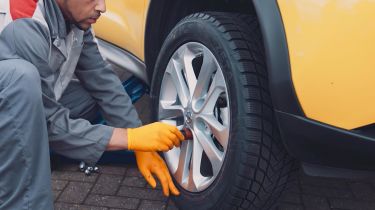How to look after your tyres
Checking your tyres for damage and ensuring your tread depth is sufficient is easy – we show you how.

Checking your tyres is one of the easiest things you can do. Whether it’s ensuring tyre pressures are correct, looking for damage or making sure your tyres have got enough tread, it’s a straightforward job you can do yourself.
Tyre pressures
Having the wrong tyre pressures can increase fuel consumption and reduce safety, so it’s essential you get them right. The correct tyre pressures will be displayed in your car, usually on a sticker in one of the door jambs or on the back of your fuel filler flap. Alternatively check your car’s handbook.
Remove the dust cap on each tyre in turn and use a tyre pressure monitor to measure the pressure. You’ll need to press the tyre pressure monitor onto the tyre’s valve in accordance with the monitor’s instructions. If they’re underinflated, pump up the tyre. If they’re overinflated let out some air by pressing the valve with your fingernail.
Many foot pumps and electric tyre compressors, including those you’ll find in many petrol stations, feature a tyre pressure gauge so you can check and inflate at the same time.
It’s essential your tyres are inflated correctly – too much or too little air, and your car’s ability to grip the road will be seriously compromised. Plus you could increase tyre wear and fuel consumption.
Checking tyre condition and tread depth
Checking tyres for damage is fairly straightforward. If there are any cuts, cracks or bulges in your tyre, it’s time you replaced them.
Examining your tyres’ tread depth is a little more involved, but absolutely essential. The rules on tread depth are clear – you must have at least 1.6mm of tread over the central three-quarters of your tyre around the entire circumference.
Any less and you’ll be putting yourself, your passengers and other road users at risk. If you’re caught driving with insufficient tread depth, you could face a hefty fine.
To check your tyre’s tread depth you can use a tread depth gauge, which you can buy from most car spares shops. The gauge has a protruding rod on the end, which you’ll need to push gently into your tyres’ tread. The other end of the gauge has a measure which tells you how much tread you have.
The alternative is to use a 20p coin. The outer rim of the coin is approximately 1.6mm, so if you can see any of the rim, you’ll need a new tyre.
While 1.6mm is the minimum legal requirement, you should consider replacing your tyres when the tread passes 3mm as grip deteriorates quickly after this point.
You should never mix brands of tyres, particularly across the same axle, so both front tyres match for example. Speak to your main dealer or local tyre fitter for advice.
Most Popular

Suzuki’s new 10-year warranty is free – here’s how to get it

Omoda E5 targets rivals: now with zero deposit and APR
Tips & advice

Car dashboard warning lights: what does each symbol mean?

Electric car charging stations: public networks, charger types, apps and maps







